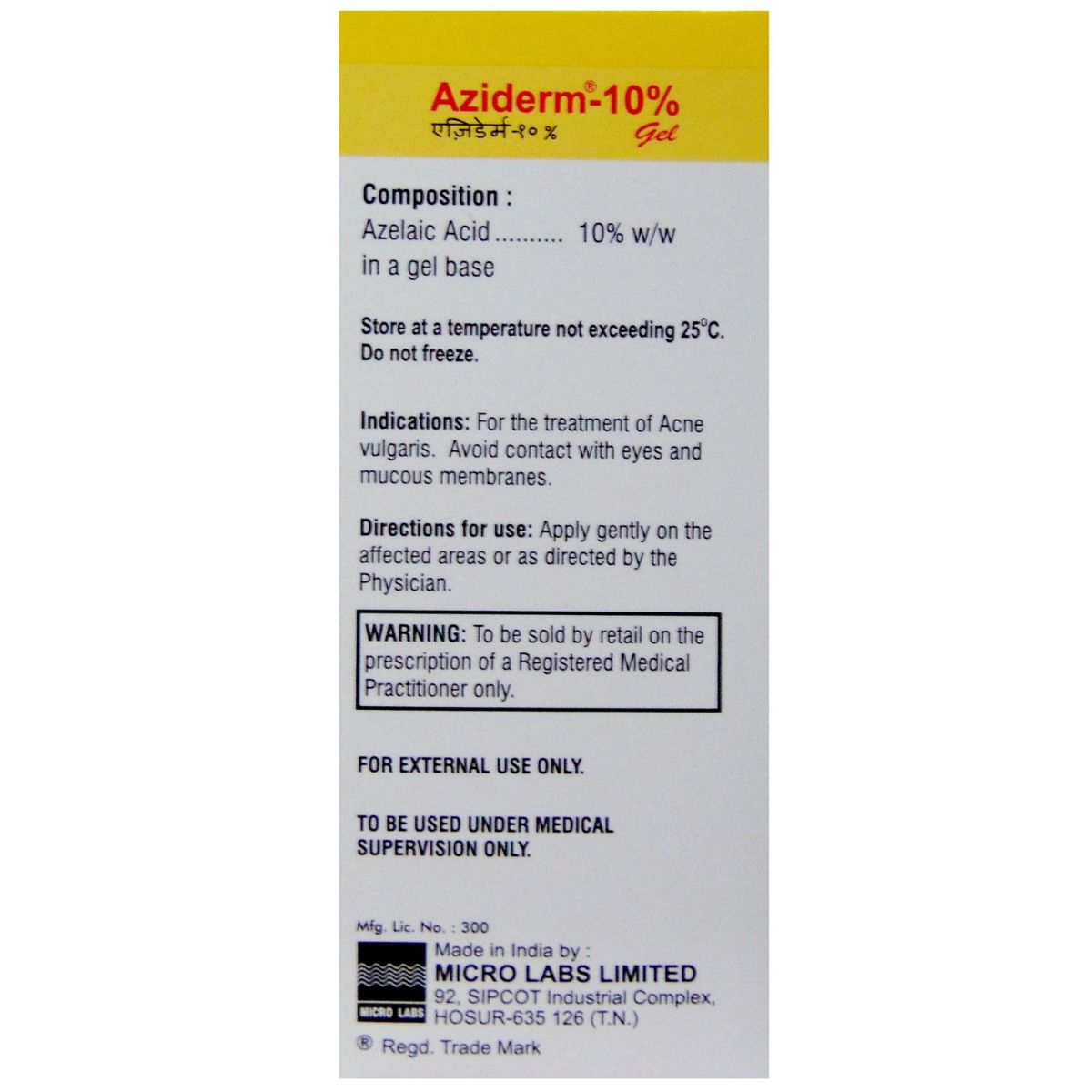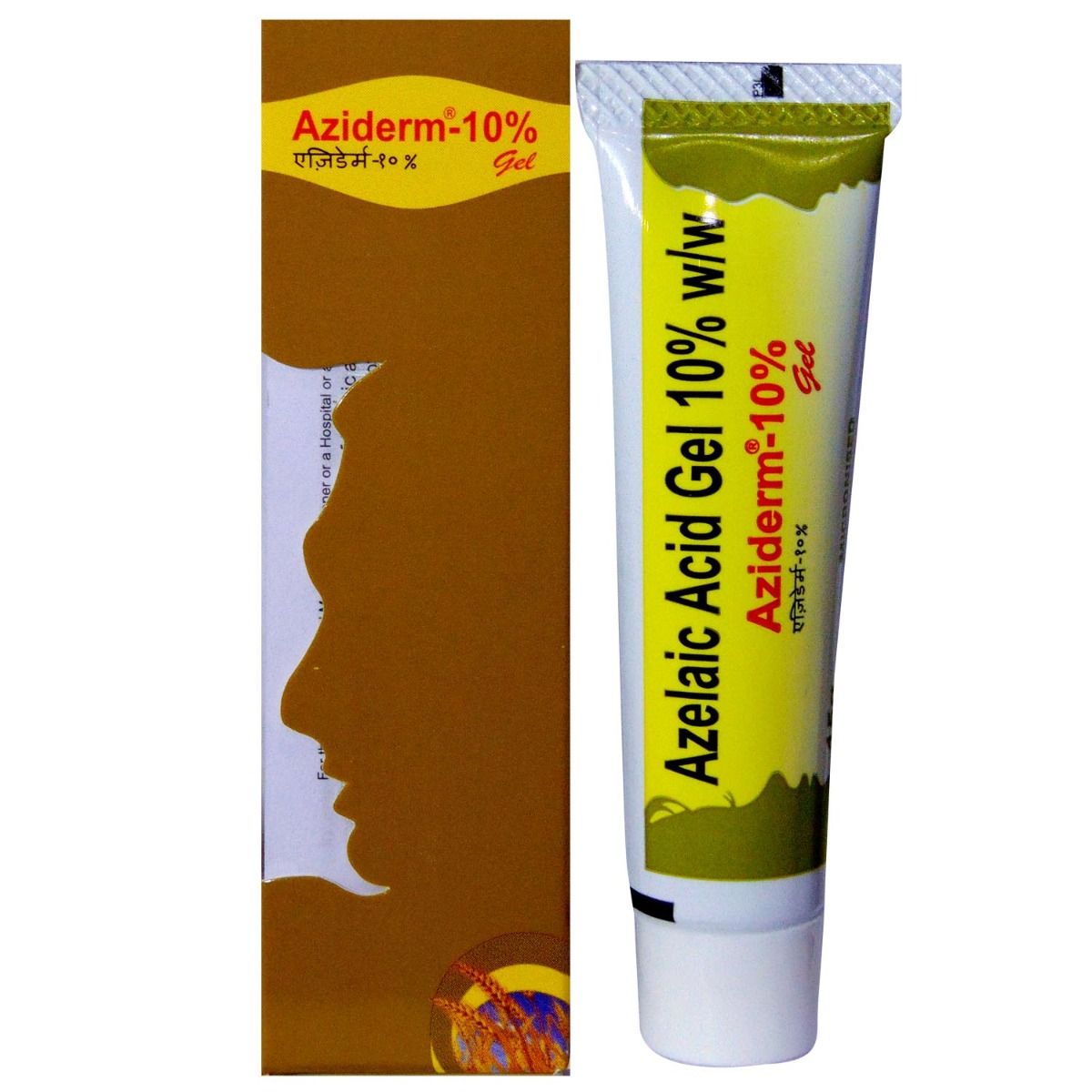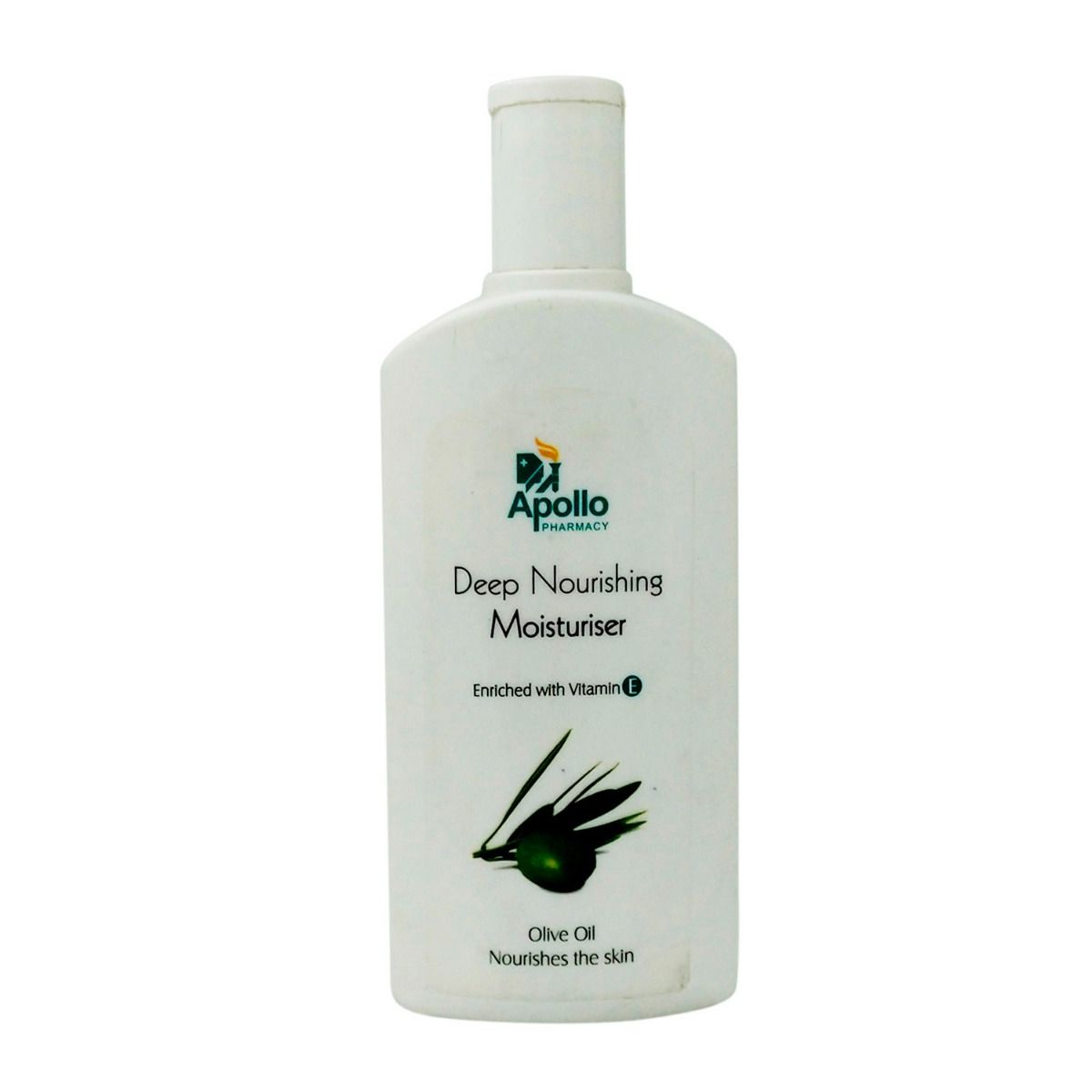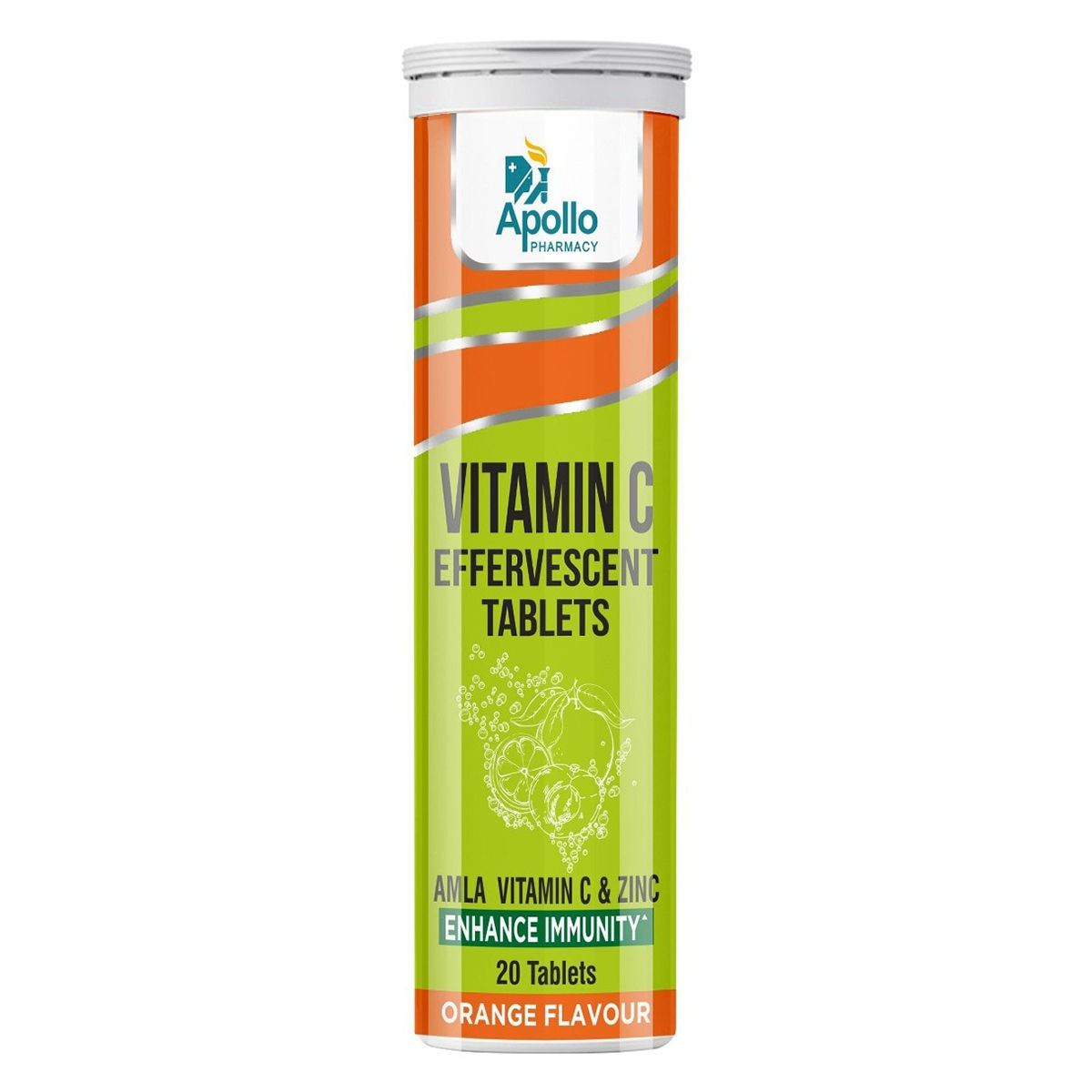Aziderm 10% Gel 15 gm



₹277
(Inclusive of all Taxes)
₹41.5 Cashback (15%)
Aziderm 10% Gel is used for the treatment of mild to moderate papulopustular acne and papulopustular rosacea on the face. It helps reduce inflamed pimples and pustules, calms redness, and improves skin clarity with regular use. It contains Azelaic acid, which kills bacteria and reduces inflammation, making acne less visible, less red, and less irritated. It may cause common side effects such as dryness, burning, irritation, and dermatitis.
Know Your Delivery Time
Provide Delivery Location
 Prescription drug
Prescription drugWhats That

Secure Payment

India's Most Trusted Pharmacy

Genuine Products
Composition :
Manufacturer/Marketer :
Consume Type :
Return Policy :
Expires on or after :
About Aziderm 10% Gel
Aziderm 10% Gel is used to treat red, swollen acne spots (like papules and pustules) and to reduce facial redness and bumps caused by rosacea. Acne is a skin condition caused when the hair follicles are plugged with oil and dead skin cells. It can cause whiteheads, blackheads and pimples. Rosacea is a skin disease that causes redness, flushing, and pimples on the face.
Aziderm 10% Gel contains 'Azelaic acid,' which is a bactericidal (kills bacteria) agent. It is a naturally occurring aliphatic dicarboxylic acid that helps stop the growth of acne-causing bacteria and reduces keratin production, which helps prevent the formation of comedones (clogged pores).
Aziderm 10% Gel is for external use only. Avoid contact with eyes, eyelids, lips, mouth and nose. If the medicine comes into contact with any of these areas, rinse the area immediately with water. Common side effects of Aziderm 10% Gel include dryness, peeling, burning, irritation, itching and dermatitis. These side effects may not occur in every patient using this medication and may differ individually. If the side effects persist longer or worsen, please seek a doctor’s advice.
If you are allergic to Aziderm 10% Gel or any other medications, inform your doctor. If you are pregnant or breastfeeding, it's important to consult your doctor before using Aziderm 10% Gel. Avoid using Aziderm 10% Gel in excessive doses or for prolonged periods, as this may lead to adverse effects. Do not apply Aziderm 10% Gel to open wounds, cuts, scrapes, or damaged skin. Aziderm 10% Gel may make asthma worse. Consult your doctor if your asthma worsens while using Aziderm 10% Gel.
Uses of Aziderm 10% Gel
Aziderm 10% Gel is used in the treatment of inflammatory skin conditions affecting the face. The detailed uses of Aziderm 10% Gel are as follows: <br/> • Treatment of papulopustular rosacea: Reduces the inflammatory papules and pustules associated with mild to moderate rosacea.<br/> • Relief from papulopustular acne: Treats mild to moderate acne with inflammatory pimples and pus-filled areas.<br/> • Reduction of skin redness: Reduces visible redness and irritation associated with rosacea and acne.<br/> • Antibacterial action: Aziderm 10% Gel kill bacteria on the skin that contribute to acne and rosacea flare-ups.<br/> • Improves skin clarity: Promotes clearer, smoother skin by reducing pore blockage and inflammation.<br/>
Directions for Use
- Follow your doctor's instructions on the dosage and timing of this medication to ensure safe and effective use.
- Take the advised amount of Aziderm 10% Gel and apply it as a thin layer on the clean and dry affected area as prescribed by your doctor.
- Aziderm 10% Gel is for external use only. Avoid contact with the eyes, ears, nose, and mouth. If Aziderm 10% Gel comes into contact with the eyes, nose, or mouth, rinse with water immediately.
Medicinal Benefits
Aziderm 10% Gel treats acne (pimples) and rosacea (redness and visible blood vessels on the face). It contains 'Azelaic acid', a dicarboxylic acid with antibacterial, keratolytic, comedolytic (inhibiting the formation of blemishes), and antioxidant activity. Aziderm 10% Gel is bactericidal and inhibits the synthesis of microbial cellular proteins. It clears the pores of bacteria that cause irritation and breakouts.
How Aziderm 10% Gel Works
Storage
- Consult your doctor if you experience skin redness, itching, or irritation after taking medication.
- Your doctor may adjust your treatment plan by changing your medication or providing guidance on managing your erythema symptoms.
- Your doctor may recommend or prescribe certain medications to help alleviate symptoms.
- Apply cool compresses or calamine lotion to the affected skin area to reduce redness and itching.
- Stay hydrated by drinking plenty of water to help alleviate symptoms and keep your skin hydrated.
- Monitor your skin condition closely and promptly report any changes, worsening symptoms, or concerns to your healthcare provider.
- Moisturize frequently with thick, broad-spectrum moisturizers containing sunscreen.
- Use warm water for short baths, and gentle cleansers.
- Pat dry and apply moisturizer immediately.
- Use a humidifier to add moisture to the air, and choose breathable fabrics like cotton and silk.
- Wash clothes with fragrance-free detergents to minimize irritation.
- Consult your doctor if you experience skin redness, itching, or irritation after taking medication.
- Apply cool compresses or calamine lotion to the affected skin area to reduce irritation.
- Stay hydrated by drinking plenty of water to help alleviate symptoms and keep your skin soothing.
- Monitor your skin condition closely and promptly report any changes, worsening symptoms, or concerns to your healthcare provider.
- Change positions or take a break from activity to relieve symptoms.
- Avoid postures that put a lot of pressure on just one area of the body.
- If you have vitamin deficiency, take supplements or change your diet.
- Exercise regularly like cycling, walking or swimming.
- Avoid sitting with your legs crossed.
- Clench and unclench your fists and wiggle your toes.
- Massage the affected area.
- Report the itching to your doctor immediately; they may need to change your medication or dosage.
- Use a cool, damp cloth on the itchy area to help soothe and calm the skin, reducing itching and inflammation.
- Keep your skin hydrated and healthy with gentle, fragrance-free moisturizers.
- Try not to scratch, as this can worsen the itching and irritate your skin.
- If your doctor prescribes, you can take oral medications or apply topical creams or ointments to help relieve itching.
- Track your itching symptoms and follow your doctor's guidance to adjust your treatment plan if needed. If the itching persists, consult your doctor for further advice.
- Consult and seek guidance from a doctor or healthcare expert to determine the cause and best course of treatment.
- Avoid harsh products, extreme temperatures, and other potential irritants that may exacerbate the issue.
- Depending on the location and severity of the burning, your healthcare professional may recommend applying a soothing or protective agent, such as a cream, gel, or ointment.
- Keep the affected area clean to promote healing and prevent further irritation.
- Schedule follow-up appointments with your healthcare professional to monitor your symptoms and adjust your treatment plan as needed.
- If the burning or irritation persists or worsens, seek medical attention for further guidance and treatment.
- Inform your doctor right away if you notice any changes in your skin colour where you applied the medicine; they might need to adjust your dose or stop it temporarily.
- If needed, your doctor may suggest using creams containing medicines like retinoids, hydroquinone, or azelaic acid to help lighten the discoloration.
- Apply sunscreen with a high SPF when going outside to prevent further darkening of the affected areas.
- Wearing protective clothing and staying in the shade can also help keep the discoloration from getting worse.
- Avoid smoking and using harsh chemicals, as they can harm your skin and cause more discoloration.
What if I have taken an overdose of Aziderm 10% Gel
Drug Warnings
Do not use Aziderm 10% Gel if you are allergic to Aziderm 10% Gel or any of its components. Please inform your doctor if you are using any prescription and non-prescription medications you are taking, including vitamins, before starting Aziderm 10% Gel. Aziderm 10% Gel can make the skin change colour, especially when the skin is dark in colour. It is recommended to avoid tanning booths and sunlamps. Do not apply Aziderm 10% Gel to the irritated and sunburned skin. Please limit the use of products that contain large amounts of alcohol (astringents, shaving creams or after-shave lotions), hair removal products, and products containing lime or spices while using Aziderm 10% Gel. Pregnant and breastfeeding women should consult their doctor before using Aziderm 10% Gel.
Drug-Drug Interactions
Drug-Drug Interactions
Login/Sign Up
Drug-Food Interactions
Drug-Food Interactions
Login/Sign Up
Diet & Lifestyle Advise
- Avoid harsh products on your skin.
- Do not share cosmetic products, face towels, and bathing bars.
- Manage stress, eat healthily, drink plenty of water, exercise regularly, and get plenty of sleep.
- Avoid or limit the intake of alcohol and caffeine.
- Rinse your face with water several times a day to avoid breakouts.
- Do not scratch or pick your skin to avoid infecting the affected area.
- Hydration is important in managing acne; hence, drink 3-4 litres of water daily to eliminate toxins from the body.
- Include anti-inflammatory foods in your diet.
Habit Forming
Therapeutic Class
Aziderm 10% Gel Substitute

Product Substitutes
Alcohol
Consult your doctor
The interaction of Aziderm 10% Gel with alcohol is unknown. Please consult your doctor in case of any concerns.
Pregnancy
Consult your doctor
Please consult your doctor before using Aziderm 10% Gel if you are pregnant or planning to conceive.
Breast Feeding
Consult your doctor
There are limited studies on how Aziderm 10% Gel affects breastfed infants. Please consult your doctor before using Aziderm 10% Gel if you are breastfeeding. If you need to apply Aziderm 10% Gel on your breasts, don't do this shortly before giving a feed.
Driving
Not applicable
Aziderm 10% Gel usually does not interfere with your driving ability and is safe to use.
Liver
Consult your doctor
Let your doctor know if you have any history of liver disease before using Aziderm 10% Gel.
Kidney
Consult your doctor
Let your doctor know if you have any history of kidney disease before using Aziderm 10% Gel.
Children
Caution
Aziderm 10% Gel is not recommended for use in children as the safety and efficacy is not established.

Have a query?
FAQs
Aziderm 10% Gel is used for the treatment of mild to moderate papulopustular acne and papulopustular rosacea on the face.
Aziderm 10% Gel contains 'Azelaic acid,' which is a bactericidal (kills bacteria) agent. It is a naturally occurring aliphatic dicarboxylic acid that helps stop the growth of acne-causing bacteria and reduces keratin production, which helps prevent the formation of comedones (clogged pores).
Your doctor may advise the initial dose as once daily in the evening. The dose may be increased to twice or thrice daily in the morning and evening.
Aziderm 10% Gel usually improves your skin condition in four weeks of treatment. If you notice no improvement after a month of treatment, please reach out to your doctor. For best results, the doctor may advise you to use Aziderm 10% Gel regularly for several months.
It is advised to limit the use of products that contain large amounts of alcohol (astringents, shaving creams or after-shave lotions), hair removal products, and products containing lime or spices if you are using Aziderm 10% Gel.
It is not recommended to use Aziderm 10% Gel for the treatment of melasma. Aziderm 10% Gel is only useful in treating acne, rosacea and its associated conditions.
The amount of Aziderm 10% Gel you should apply is determined by the region of your skin prone to acne. Your physician or dermatologist may advise you on how much to take.
Apply the advised amount with clean and dry hands to the skin's affected areas. Gently massage the medicine into the skin with your fingers. Wash your hands before and after applying. Do not put dressing or bandage on the affected areas.
It's generally recommended to use Aziderm 10% Gel for several weeks or months after your acne clears to prevent recurrence.
Common side effects of Aziderm 10% Gel include dryness, peeling, burning, irritation, itching, and dermatitis. These side effects may not occur in every patient using this medication and may differ individually. If the side effects persist longer or worsen, please seek a doctor's advice.
Aziderm 10% Gel is generally not recommended for children. It's essential to consult with a paediatrician for appropriate acne treatment options.
While it's generally safe for long-term use, it's essential to consult a dermatologist to assess your needs and monitor for any potential side effects.
Country of origin
Manufacturer/Marketer address
Customers Also Bought
Disclaimer
Author Details
We provide you with authentic, trustworthy and relevant information
Buy best Dermatology products by
Others
AYUR
FIXDERMA
MINTOP
BIODERMA
KETO
CANDID
TUGAIN
VENUSIA
SELSUN
BETADINE
UV DOUX
ELOVERA
NEVLON
ABZORB
ONABET
DERMADEW
MINOIL
MOISTUREX
MORR
BIOLINE
Canesten
REJUGLOW
TRICOMAX
UVAVO
ACTAME
CLOCIP
Excela
KENZ
KETAFUNG
KETOMAC
KOZICARE
KZ
MELALUMIN
OLESOFT
SLC
ZENSOFT
ZORAY
CIPHANDS
ECOKET
MEDERMA
MELAGARD
OILATUM
PARASOFT
PHOTON
REJUHAIR
SOLSET
SUDERMA
SUNSTOP
8X
BILUMA
DEWDERM
DEWSOFT
DUCRAY
DYSIS
HELIOCARE
KETOL
KETOPZ
MELAGLOW
MESODEW
MINOPEP
PMT
SOLASAFE
SUNBAN
TRUDERMA
ACCARE
ACMED
AQUASOFT
COSALIC
DANCLEAR
DEPISHINE
Evion
GLAMBAK
GLYMED
GOLITE
HAIRGUARD
Hair Shield
KTC
L-SKIN
LACNE
LOZISOFT
NIXIPER
PERITOP
PERMED
PHOTOSTABLE
PHYSIOGEL
PSOROLIN
Q-SERA
RITCH
SOFIDEW
SUNCROS
SUNMATE
TETMOSOL
TVAKSH
UNISON
YUVINIE
A-DERMA
ACNE-UV
ACNESTAL
ACNESTAR
ACNETHRO
AHAGLOW
ALOCERENE
ALZIROL
AQUAHOLD
ATBRO SAFEXX
AVEIL
B-GLOW
BACTORUB
BENXOP
BLYNDS
CERASOFT
CLEAR
CLINSOL
COLOPLAST
CUVIA
DEOPHIN
DR. MOREPEN
Dabur
E-DEW
EKRAN
ETHIGLO
Enshine
FUSIGEN
GLOWRIANCE
HAIR 4U
HYDROMAX
KERAGLO
KETOFLY
KETOKEM
KETOSTAR
KLINIQUE
LA SCREEN
MEDILICE
MICROSHIELD
MMS
NANZILON
NIZRAL
NOSCAB
OLEMESSA
PHOTOBAN
PHYTORAL
PROTEK
RENOCIA
RING GUARD
SALIAC
SALISIA
SCABELICE
SCABPER
SERIVA
SESDERMA
SHYN-ON
TARICH
TRIRISE
ULTRA
URIAGE
UV BLUE
UVHOLD
XEMOSE
ZOHAIR
1M
ACNEGUARD
ACRIFLAVINE
ADCROSS
ADONIA
ADONIS
AFK
AHD
ALCONANZ
APIFIL
AQUADERM
AVARTA
AVENE
AZAC
BELLA
BELZOLE
BENZAC
BIOLAGE
BIOWRIGHT
BURNOL
CALADRYL
CANZOL
CAREMOIST
CASIL
CETRILAK
CICATRIX
CLENSTA
CUTICAPIL
CUTICOLOR
CUTILOCK
DANDEL PLUS
DEPIWHITE
DM
DOUX
Dermifree
E ACNE
ENMASK 50
ENTICE
EPISOFT
EXIZOL
Eloway
FAIR INSTA
FEMCINOL
FULUCIOUS
GETRYL
GORGEUS
GRIP HAIR
GUNEERA
HAIR YUTH
HAIRVITAL
HH MITE
HIDRATE
HOLLISTER
HYDRAVO
I-GLOW
JOYNECA
JUENE
KERASHINE
KETZI
KIDGLO
KROMAGLO
LACTIFEM
LACTO CALAMINE
LAGLO
LAVO
LIPZ
LOGIHAIR
LUCIARA
MEDRAYS
MELNORA BLUV
MICROSTERILE
MILDY
MINIMALIST
NEUTRIDERM
NMFE
NO SCARS
NOVALE
NUFORCE
Nourish
OAKNET
P-SCAB
PAPULEX
PERCOS
PREGNACARE
Pirfesca
RACINE
RADIBAN
RASHFREE
REGALIZ
Rashcare
SAPAT
SEBANDRO
SEBORBAR
SEREN
SESTRY
SHADOWZ
SISLA
SKINBRITE
SOLECROSS
STERILLIUM
SUN KROMA
SUNBLESS
SUNCLIP
SUNGRACE
SUNHEAL
SUNKROMA
SUNTRIS
TAIYU
TEDIBAR
THERUPTOR
TRICHOZ
TRICOGRO
TRIFLOW
TRIGAINE
ULTICREEN
UPROOT
UV BREAK
UV KOT
UV STOP
UVCROSS
UVNEX
UVSMART
VCX
VIRCOCO
WANISH
WELL GROW
XYTRESS
YU REVERZO
Z BLOCK
ZINDERM
Glenmark Pharmaceuticals Ltd
Sun Pharmaceutical Industries Ltd
Cipla Ltd
Klm Laboratories Pvt Ltd
Canixa Life Sciences Pvt Ltd
Abbott India Ltd
Ajanta Pharma Ltd
Intas Pharmaceuticals Ltd
Dr Reddy's Laboratories Ltd
East West Pharma India Pvt Ltd
Alkem Laboratories Ltd
Hegde & Hegde Pharmaceutica Llp
Brinton Pharmaceuticals Ltd
Atopic laboratories Pvt Ltd
Amwill Healthcare Pvt Ltd
Leeford Healthcare Ltd
Torrent Pharmaceuticals Ltd
Palsons Derma Pvt Ltd
Oaknet Healthcare Pvt Ltd
Med Manor Organics Pvt Ltd
Ipca Laboratories Ltd
Micro Labs Ltd
Fixderma India Pvt Ltd
Apex Laboratories Pvt Ltd
Dermocare Laboratories Gujarat Llp
Skinocean Pharmaceuticals
Yaher Pharma
Mankind Pharma Pvt Ltd
Dermacia Healthcare
Systopic Laboratories Pvt Ltd
Menarini India Pvt Ltd
Nemus Pharmaceuticals Pvt Ltd
Lupin Ltd
Ethinext Pharma
Zydus Cadila
Inex Medicaments Pvt Ltd
Kivi Labs Ltd
Talent India Pvt Ltd
GlaxoSmithKline Pharmaceuticals Ltd
Sol Derma Pharmaceuticals Pvt Ltd
Wallace Pharmaceuticals Pvt Ltd
Zydus Healthcare Ltd
Mrhm Pharma Pvt Ltd
Eskon Pharma
Glowderma Lab Pvt Ltd
Newtrimed Healthcare Pvt Ltd
Regaliz Medicare Ltd
Hbc Dermiza Healthcare Pvt Ltd
La Pristine Bioceuticals Pvt Ltd
Mohrish Pharmaceuticals Pvt Ltd
Rockmed Pharma Pvt Ltd
Percos India Pvt Ltd
Elder Pharmaceuticals Ltd
Praise Pharma
Aurel Biolife
Ethicare Remedies Pvt Ltd
Kaizen Drugs Pvt Ltd
Macleods Pharmaceuticals Ltd
Biocute Life Care
Galcare Pharmaceuticals Pvt Ltd
Wockhardt Ltd
Rely On Pharmaceuticals
Zee Laboratories Ltd
Indiabulls Pharmaceuticals Pvt Ltd
La Med Healthcare Pvt Ltd
Prism Life Sciences Ltd
Yap Bioceuticals
Adonis Laboratories Pvt Ltd
P and P Dermaceuticals Pvt Ltd
Yash Pharma Laboratories Pvt Ltd
Apple Therapeutics Pvt Ltd
West Coast Pharmaceuticals Pvt Ltd
Albatross Healthcare Pvt Ltd
Alniche Life Sciences Pvt Ltd
Galderma India Pvt Ltd
Gary Pharmaceuticals Pvt Ltd
Dermajoint India
FDC Ltd
Karlin Pharmaceuticals & Exports Pvt Ltd
Salve Pharmaceuticals Pvt Ltd
Arka Vital Science Pvt Ltd
Iceberg Health Care Pvt Ltd
Lyra Laboratories Pvt Ltd
Skinska Pharmaceutica Pvt Ltd
Akumentis Healthcare Ltd
Grace Derma Healthcare Pvt Ltd
Uniza Healthcare Llp
Alembic Pharmaceuticals Ltd
Dabur India Ltd
Dermarex HealthCare India Pvt Ltd
Entod Pharmaceuticals Ltd
Indchemie Health Specialities Pvt Ltd
Leogard Pharmaceuticals Pvt Ltd
Olcare Laboratories Pvt Ltd
Connote Healthcare
Cosmofix Technovation Pvt Ltd
Indolands Pharma Pvt Ltd
Cadila Pharmaceuticals Ltd
Emcure Pharmaceuticals Ltd
Human Pharmaceuticals
Jenburkt Pharmaceuticals Ltd
Naos Skincare India Pvt Ltd
Cadila Healthcare Ltd
Canbro Healthcare
Dhamus Pharma
Monichem Healthcare Pvt Ltd
Oziel Pharmaceuticals Pvt Ltd
Psychotropics India Ltd
Rivan Pharmaceuticals Pvt Ltd
Unison Pharmaceuticals Pvt Ltd
Aktis Pharma India Pvt Ltd
Anhox Healthcare Pvt Ltd
Bioswizz Pharmaceuticals Ltd
Cyrus Remedies Pvt Ltd
Senechio Pharma Pvt Ltd
Velite Healthcare
Biochemix Health Care Pvt Ltd
Capital Pharma
Floris Skin Care
Fulford India Ltd
Izng Healthcare Pvt Ltd
NuLife Pharmaceuticals
Omniceutics Healthcare Pvt Ltd
Palsons Drugs & Chemical Industries Pvt Ltd
Pure Derma Healthcare Pvt Ltd
Remember India Medicos Pvt Ltd
Torque Pharmaceuticals Pvt Ltd
Trikona Pharmaceuticals Pvt Ltd
Delbruk Lifescience Pvt Ltd
Encore Healthcare Pvt Ltd
Glasier Wellness Inc
Laborate Pharmaceuticals India Ltd
Masaya Pharmaceuticals Pvt Ltd
Medcure Organics Pvt Ltd
Rhine Biogenics Pvt Ltd
SMG Global Pharma
Stedman Pharmaceuticals Pvt Ltd
Vts Life Sciences
Win Medicare Ltd
Biochem Pharmaceutical Industries Ltd
Cute Care Life Sciences Pvt Ltd
Cutinova Healthcare Pvt Ltd
Eris Life Sciences Ltd
Indoco Remedies Ltd
Kaizen Research Labs India Pvt Ltd
Maxamus Pharma Pvt Ltd
Mesova Pharmaceuticals
Nuface Pharma
Prevego Healthcare & Research Pvt Ltd
Sedge Bioceuticals Inc India
USV Pvt Ltd
Avigenix Innovations Pvt Ltd
Bellissa Pharmaceuticals Pvt Ltd
Fourrts India Laboratories Pvt Ltd
Hetero Healthcare Pvt Ltd
Johnson & Johnson Pvt Ltd
Kshipra Health Solutions
Linux Laboratories Pvt Ltd
Livia Healthcare Llp
Mylan Pharmaceuticals Pvt Ltd
Parker Robinson Pvt Ltd
Pasteur Laboratories Pvt Ltd
Skinnovation Pvt Ltd
Universal Twin Labs
A. Menarini India Pvt Ltd
Adonis Phytoceuticals Pvt Ltd
Ancalima Lifesciences Ltd
Aristo Pharmaceuticals Pvt Ltd
Biocon Ltd
Biopharmacieaa Pvt Ltd
Caryota Labs India Pvt Ltd
Curious Biotech
Embark Lifescience Pvt Ltd
Eumedica Pharamceuticals
Geno Pharmaceuticals Pvt Ltd
Kepler Healthcare Pvt Ltd
Morepen Laboratories Ltd
Omni Lifesciences Pvt Ltd
Surecare Pharma Pvt Ltd
Zhenpi Life Sciences Pvt Ltd
Adroit Biomed Ltd
Caviar Derma Care
Cresol Pharmaceuticals Pvt Ltd
Forman Medics Pvt Ltd
Regium Pharmaceuticals
Shalaks Pharmaceuticals Pvt Ltd
Woakes Pharma
Briskinn Solutions
Heptagon Life Sciences Pvt Ltd
Liva Health Care Ltd
Nanz Med Science Pharma Pvt Ltd
Panzer Pharmaceuticals Pvt Ltd
RAYAM PHARMA LTD
Smart Laboratories Pvt Ltd
Syscutis Health Care
Tas Med India Pvt Ltd
Tricos Dermatologics Pvt Ltd
Ceuticoz
Corona Remedies Pvt Ltd
Cosmederma Remedies
Derma Edge Pharma Llp
Dermazone Pharmaceuticals Pvt Ltd
Dermonova Pharma Pvt Ltd
Dvacos Cosmetics And Neutraceuticals Pvt Ltd
Franco Indian Pharmaceuticals Pvt Ltd
Iberia Skin Brands India Pvt Ltd
Ind Swift Laboratories Ltd
Innovative Life Sciences Pvt Ltd
Mlt Laboratories Pvt Ltd
Organic Pharmaceuticals Pvt Ltd
Pretium Pharmaceuticals
Roxters Pharma
SG Lifecare Pvt Ltd
Bio Swizz Pharmaceuticals
Cnx Health Care Pvt Ltd
Cubit Healthcare
Cutik Medicare Pvt Ltd
D D Pharmaceuticals Pvt Ltd
Dermia Conticare Pvt Ltd
Genees Pharmaceutical Pvt Ltd
Granvalor Pharmaceuticals Pvt Ltd
H&B Wellness
Hetero Drugs Ltd
Hexadox Pharmaceuticals Pvt Ltd
Mavin Pharmaceuticals
Medishri Healthcare Pvt Ltd
Mediste Pharmaceuticals Pvt Ltd
Menarini Raunaq Pharma Ltd
Nidus Pharma Pvt Ltd
Priomed Life Sciences Pvt Ltd
Prosit Healthcare Pvt Ltd
Strenuous Healthcare Pvt Ltd
Yuderma Laboratories Pvt Ltd
Abia Pharmaceuticals Pvt Ltd
Aclaris Therapeutics Inc
Anglo French Drugs & Industries Ltd
Avriva Skintech Pvt Ltd
Cardea Biotech
Caryota Life Sciences India Pvt Ltd
Ciaga Pvt Ltd
Cipla Health Ltd
Craza Lifesciences Pvt Ltd
Cutis Biotech
Dwd Pharmaceuticals Ltd
Ethiall Remedies
Galpha Laboratories Ltd
Group Pharmaceuticals Ltd
Innovax Pharmaceuticals Llp
Laomai Therapeutics
Lincoln Pharmaceuticals Ltd
Novell Biolabs Pvt Ltd
Resilient Cosmeceuticals Pvt Ltd
Skin Kinetics Pharmaceuticals Pvt Ltd
Stiefel India Pvt Ltd
Sun Life Sciences Pvt Ltd
Tergum Remedies Pvt Ltd
Timon Pharmaceuticals Pvt Ltd
Unimarck Pharma India Ltd
Wings Pharmacuticals Pvt Ltd
Adroit Lifescience Pvt Ltd
Alienist Pharmaceutical Pvt Ltd
Avancer Labs (P) Ltd
Avelino Healthcare Ltd
BDR Pharmaceuticals Internationals Pvt Ltd
Bal Pharma Ltd
Bayer Pharmaceuticals Pvt Ltd
Biumark Dermaceuticals Pvt Ltd
Cure N Cure Pharmaceuticals Ltd
Depsons Healthcare
Der-Joint Healthcare Pvt Ltd
Dermakare Pharmaceuetical Pvt Ltd
Eskag Pharma Pvt Ltd
H&H Pharmaceuticals Ltd
Indi Pharma Pvt Ltd
Kentossa Pharmaceuticals
Kriya Pharmaceuticals
Life Gain Pharma Company
Mdc Pharmaceuticals Pvt Ltd
Megma Healthcare Pvt Ltd
Megmento Pharmaceutical Pvt Ltd
Organic Labs Pvt Ltd
Oswald Pharmaceuticals Pvt Ltd
Piramal Enterprises Ltd
Prokure Life Sciences
Rapross Pharmaceuticals Pvt Ltd
Seraph Life Sciences Pvt Ltd
Skintillio Healthcare Pvt Ltd
Syswin Pharmaceuticals Pvt Ltd
Transcend Therapeutics Pvt Ltd
Vivia Dermacare Ltd
Warner (India) Pharma Pvt Ltd
Yuventis Pharmaceuticals
Agrawal Drugs Pvt Ltd
Alive Life Sciences Pvt Ltd
Beta drugs Ltd
Bionova Lifesciences
Cure Tech Skincare
Dermatech Pharmaceuticals
Dolphin Laboratories Ltd
Dolphin Pharmaceutical
BODY CREAM
Body Lotion
Soap
Face Cream
Shampoo
Sun Screen
Face Gel
Face Wash
HAIR SOLUTION
Face Serum
Hair Lotion
BODY GEL
Hair Serum
Dusting Powder
ANTISEPTIC
FACE CLEANSER
Body Wash
Face Lotion
Body Spray
Conditioner
FUNGAL INFECTION
Foot Cream
Eye Cream
Cleanser
Eye Gel
Hair Cream
Hair Spray
Hair Gel
Specialty Supplements
Face Mask
Moisturiser
Sanitizer
Hair Oil
Lip Balm
Skin Ointment
Eye Serum
Hand Cream
Facial Spray
SPECIALITY SUPPLEMENT
Capsule
Face Toner
Hair Mask
Intimate Wash
Talcum Powder
BABY SUNSCREEN
Body Butter
Body Scrub
DIAPER RASH CREAM
EYE SOLUTION
FACIAL WIPE
Hair Tonic
Hand Wash
Lip Serum
Lubricant Gel
MEDICATED CREAM
MEDICATED SHAMPOO
Nail Polish

















